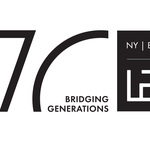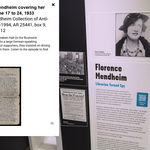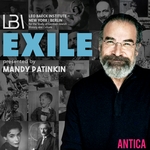Julie-Marthe Cohen Discusses Provenance Research

- Autor
- David Brown
- Datum
- Mo., 13. Mär. 2017
When Julie-Marthe Cohen visited Jewish institutions in New York to present a new handbook on provenance research in March 2017, she did not feel assured of a warm reception. “People are very concerned about time and money,” said Cohen. Provenance research, while acknowledged as an obligation by professional ethics and a broad legal consensus, is neither cheap nor easy for libraries and museums.
While concerns that provenance research can be a drain on resources are real, Cohen found that a lack of knowledge is one of the chief hurdles. “I hadn’t expected people to be so happy about the handbook,” said the curator at the Jewish Historical Museum of Amsterdam. In fact, colleagues at the LBI, the Center for Jewish History, and the Jewish Museum welcomed the addition of a new resource that would demystify the work of provenance sleuthing.
The idea for the handbook emerged during preparations for the Terezin Declaration at the Holocaust-Era-Assets Conference in Prague in 2009, and the project later gained financial and organizational backing from the Conference on Jewish Material Claims against Germany. Today, the handbook includes detailed guides to the main archival sources for provenance research on looted goods as well as a historical overview of looting and dispersion and an illustrated introduction to Jewish ceremonial objects in general.
The first section, covering mainly objects looted from Western and Southern Europe will be published on the Claims Conference website in September 2017, but Cohen said it is still a work in progress. “It is a dynamic document,” she said. “People will react to it and we will add resources and correct mistakes.” Cohen’s co-authors were independent curator and researcher Felicitas Heimann-Jelinek of Vienna and Ruth Jolanda Weinberger, a researcher for the Looted Jewish Art and Cultural Property Initiative of the Claims Conference.
The handbook is focused on the special challenges in researching ceremonial objects. “Objects are often poorly described or not described at all in existing records,” said Cohen. Unlike books, which were typically cataloged and often have inscriptions or other markings, or art, which was usually photographed and described—by the looters if not the owners as well—many ceremonial objects have few identifying details. Further complicating matters is the fact that many ceremonial objects were mass produced beginning in the second half of the 19th century.
Advances in technology may have made ceremonial objects more difficult to identify, but the advent of digitization is making provenance research much easier. Caches of looted goods discovered by American soldiers in Germany, like those collected by Nazi ideologist Alfred Rosenberg for his “Institute for the Study of the Jewish Question,” were cataloged by the US Military Administration, and those records are now available online through a partnership between the National Archives and Records Administration and Ancestry.com. Known as “Fold3,” this commercial service can be accessed for free in the reading room of the Center for Jewish History.
The handbook explains the structure and idiosyncrasies of this massive database. For example, the collecting points at Offenbach and Wiesbaden recorded items differently. “The administration in Offenbach was not as astute as the administration in Wiesbaden,” said Cohen. “When the Offenbach depot was closed, everything that hadn’t been claimed went to Wiesbaden, where it received a number.” The Wiesbaden numbers allow an object to be tracked through various agencies to its eventual destination. Other important sources described in the handbook include the recently digitized archives of the American Joint Distribution Committee and the Central Archives of the Jewish People in Jerusalem.
One resource above all is indispensable in provenance research, said Cohen. “Luck. Sometimes you just have to be lucky.”

“Quovadience”
Cohen and Heimann-Jelinek also coined a new term, “Quovadience”, for research that aims to locate missing objects. “Quovadience means starting from much less information,” she said. She cited an example of successful quovadience research from her own museum, which had records showing that the Jewish community of Leiden had loaned a Torah mantle to the Amsterdam museum in 1936, which was no longer in the collections. Through archival research, Cohen determined that the mantle had been sent to the Israel Museum in Jerusalem. Leiden was able to reclaim the exquisite silk-velvet mantle with gold-thread embroidery as its property but placed it on permanent loan to the Israel Museum.
Aktuelles





